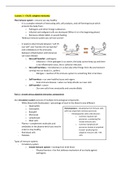Samenvatting
Immunology lectures summary BSc Biomedical Sciences, 2021/2022
- Vak
- Immunology
- Instelling
- Vrije Universiteit Amsterdam (VU)
!!!!I passed the course with an 8 by studying all the material in this document!!! This document contains a summary of the lectures and lecture slides. I added everything from the lectures and also some additional information from the book to make it more clear.
[Meer zien]













